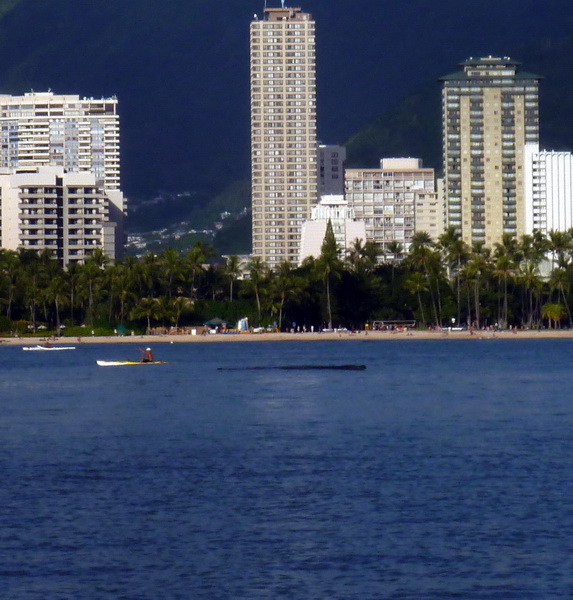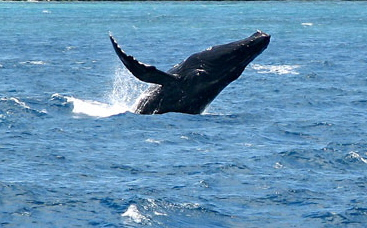Published in the Ocean Watch column, Honolulu Star-Advertiser © Susan Scott
January 17, 2011
Between a mom and baby humpback whale waving hello, and news of an orca visiting swimmers off Kihei, I’ve had a warm welcome home from Midway.
Last week while sailing with friends off the Ala Wai Boat Harbor for a late afternoon cruise, the three of us aboard spotted a humpback whale.

This isn’t unusual, because about 12,000 of these 40- to 45-foot-long whales travel to Hawaii from Arctic waters each winter to sing, court and bear young in our warm waters. Most females give birth in January.
The humpback whale we saw, though, was as close to the Waikiki reef as I’ve seen, and was waving its long white pectoral fins in the air as if saying hello to passing canoes and catamarans. This was no small salute. Adult humpback fins are 15 feet long.
The fin waving caused a lot of splashing, and as we sailed closer, we saw two miniature white fins mimicking the large ones. They were from a baby humpback.
After the displays, the female surfaced in even shallower water and there remained motionless. Nearby paddlers kept their pace, gliding past the long black back so smoothly we wondered whether they even saw the whale.

Our skipper and others at the scene stayed about twice the 100-yard legal limit from the resting whales, forming a wide semicircle. Soon everyone drifted away in the light breeze, leaving mom and babe to nurse or nap in peace.
When a female humpback whale with calf can swim fearlessly off busy Waikiki, and people return this trust by keeping a respectful distance or quickly moving out of their way, Hawaii is doing something right.
My whale experience was heartwarming, but a Maui reader’s recent whale sighting might more aptly be described as electrifying.
In spite of the water off Kihei being brown from runoff, Darcie e-mailed that she and some kids from her church jumped into the water anyway. As they splashed and played, several men ran to the shore, yelling for everyone to get out of the water.
When the swimmers turned around, they saw a 2-foot-tall fin above the surface about 20 yards away. The fin shape, and absence of a protruding tail fin, led the group to rule out the usual suspect, a shark. Everyone who saw the black fin thought it belonged to an orca.
Although rare in Hawaii, orcas, also called killer whales, occasionally stop by for a visit. Orcas are present in all oceans, from Arctic to Antarctic waters and just about everywhere in between. More orcas reside in cold water than warm not because of the temperature, but because that’s where the food is. Cold water has far more nutrients than does warm water.
It’s impossible to count Hawaii’s transient orcas, but a 2005 NOAA report mathematically derived an estimate of 430. This number incorporates waters within 200 miles of the Hawaiian Islands, including the Northwest chain. For such an enormous expanse of water, 430 (and maybe fewer) is a minuscule number.
In spite of their daunting name, killer whales, unless being hunted, don’t attack humans.
Darcie and her friends know they were lucky to swim with an orca, but she writes that it was “a pretty scary event.” Reasonably so. Orca males grow to 30 feet long, and females to 26 — quite a mass of muscle to be swimming behind you.
I miss Midway’s millions of seabirds, but I’m happy to be home. We have whales.

Mother Whale teaching breaching in 2007 off Honolulu
Above is the baby whale breaching. Click on images for larger view.
Video below.